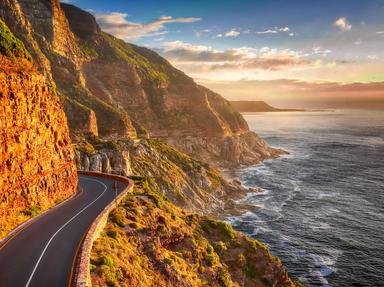Quiz Answer Key and Fun Facts
1. The Cape Winelands is the largest wine producing region in South Africa, situated in the Western Cape. The South African wine industry was established in the 1600s when the second governor of the Cape of Good Hope, Simon van der Stel, purchased and developed which wine estate in 1685?
2. Named after a Roman goddess, a fertile valley in the Western Cape is South Africa's leading producer of deciduous fruit. Which goddess is it named after?
3. Pineapples are best grown in tropical regions that are warm, humid and have constant temperatures. Pineapples in South Africa are cultivated in the Kwazulu-Natal and Eastern Cape provinces and are one of South Africa's most commercially important plants. Kwazulu-Natal accounts for a quarter of the crop and produces the Queen variety. The Eastern Cape produces the rest and grows which pepper named variety?
4. Since 1864 a particular breed of bird has been bred commercially in Oudtshoorn, found in the semi-desert Little Karoo region. Prior to World War I, these feathers were the fourth most expensive export in South Africa after gold, diamonds and wool. Which bird is it?
5. South Africa produces avocados commercially in the Mpumalanga (59%) and Limpopo (33%) regions in the north east of the country. Avocados are grown best in sub tropical regions with high rainfall in excess of 1000 mm per annum, for which these regions are renowned. Is South Africa the top avocado producer in the world?
6. South African sugar cane is grown in fourteen different areas. It extends from the Eastern Cape province on the southeastern coast to Kwazulu-Natal province along the coastal belt and then inland as far as the Mpumalanga province in the northeast. What is the average annual production of sugar in South Africa?
7. Maize (corn) is South Africa's most important crop. The maize producing area is divided into four regions - "Warm Western", "Temperate Eastern", "Cold Eastern" and "Kwazulu-Natal". Which South African province makes up a part of three of the four regions?
8. South Africa's biggest province is Northern Cape. Its capital city is Kimberley, which is the site of one of the world's largest open pit mines. The area is arid to semi arid, has very little rainfall and is perfectly suited to the farming of which livestock?
9. The North West province in South Africa is the fourth smallest province. It borders the country of Botswana and the Magaliesberg mountain range extends through the province. Most of the province consists of grassland and has some of the largest cattle herds in the world. Which river forms the southern provincial border?
10. Saldanha Bay is the largest natural bay on the south-western coast of South Africa. The town of Saldanha is a major part of the South African fishing industry and is home to many fishing canneries. Named for a Portuguese boat captain who visited South Africa in the 1500s, to which other well known South African bay was the name first attributed?
Source: Author
kino76
This quiz was reviewed by FunTrivia editor
spanishliz before going online.
Any errors found in FunTrivia content are routinely corrected through our feedback system.
